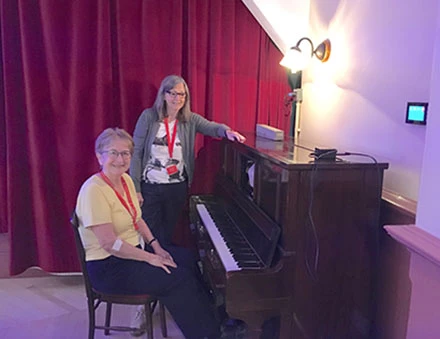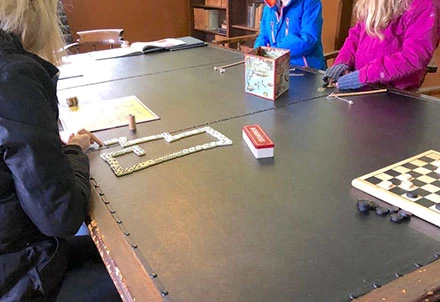No one fails to be impressed by the imposing stone building that is the Oakdale Institute. It was built in 1917, with a loan from the Tredegar Iron and Coal Company and which the miners repaid over the following years. There were no philanthropic Quaker businessmen, like Joseph Rowntree in York and George Cadbury in Bournville, to fund facilities for workers in South Wales.
As volunteers we explain the importance of the actual building but we wish it to be remembered as it was, a cultural centre for the mining community where they educated themselves and enjoyed social activities on a regular basis. We welcome visitors and over the past year have had people from many countries come in to the building from as far away as New Zealand and America.
We have had classes of school children with interesting questions and have endeavoured to bring the institute to life for them and, through stories and laughter, show them how the building was the centre of the community.
On the upper floor of the Institute is a large function room, with a sprung dance floor. One visitor we met used to live in Oakdale and recalled the room full and the floor shaking as he and his friends danced along to a live performance by Shakin’ Stevens - himself a Welshman, from Ely, Cardiff. The function room also houses a pianola, usually an object of curiosity to visitors. However, one visitor recounted how his family used to own a pianola at home, when he was a child. He and his brothers and sisters all contracted scarlet fever, a dangerous illness in the days before antibiotics. Fortunately they all survived but his parents threw the pianola and all the music rolls onto a bonfire, in case they remained sources of infection! The pianola can also be played, of course, as a piano and a visiting French student treated us to a Chopin étude. On another occasion, as the pianola played a dance tune, a couple of visitors spontaneously waltzed around the floor.
Downstairs the miners originally used the reading room, in their precious off duty time, to read newspapers and play card games and dominoes. Today there is a selection of games for children, instead, to play, although mums and dads not infrequently join in. Children wander in, with their parents telling them anxiously not to touch anything. Their reaction when they are told to choose a game is always heartwarming. We sometimes have opportunity to play the games with the children (they invariably win) and often have to explain the rules of forgotten board games to kids who are more familiar with Fortnite than draughts. It is a two way process, however and some have taught us new card games, such as Trash, which was most entertaining. The old fashioned games of snakes and ladders, Ludo, dominoes, draughts and magnetic fishing pool are still enjoyed, though. It is great, in school holiday times, to see a table full of children engrossed in winning their chosen game.
We’re looking forward to an end to the terrible coronavirus illness which is plaguing the world at this time. Oakdale survived Spanish Flu, to flourish again and we look forward to it being able to entertain visitors once again in the future.






